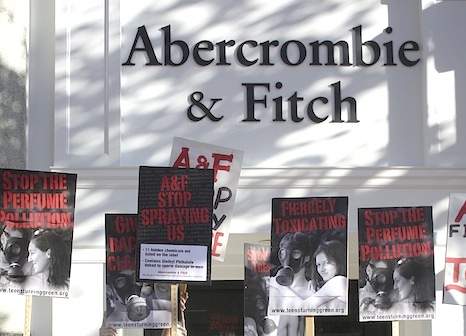Tracy’s Scented Spaces Series
This is a direct follow up to my scented diary series post on June 30th.
Recently a group of teens started a protest against Abercrombie and Fitch in San Francisco, CA. Image courtesy of Teens Turning Green. The focus of the protest—the brand’s scented store is “toxic”. The teen group has used a targeted petition, combined it with social media and a demand letter (you tube) requesting that the FIERCE fragrance not be used to scent the store.
I named this blog—The Perception of Scent because it is scent, that has the ability—negatively or positively to create an emotional drive, change the perception of logic—truth and reason—based on all how something smells. As a scent designer my goal is to achieve the positive affects from a scented space. Olfaction is tied to our limbic system home to memory and emotion, when we smell something the recall can be very powerful. My industry has commented many times, that the fragrance level used for this brand is too high for North American markets. Europe and Asia use much higher levels but their demographics have an expectation that scent should be strong. (To put the scenting space/protest in perspective- globally – protests have never happened outside of North America.)
At first, my gut reaction, this is a marketing ploy from the brand. Abercrombie and Fitch has been having financially troubles and as I wrote in June, scent marketing of this style, is shock advertising. The goal with this aggressive marketing, somewhere down the road a media/social blitz involving the power of the Y generation will evolve. Strategy accomplished!
However I do not know if this brand is that clever for the levels of fragrance they use indicate that they are destroying their personal care brand market. Now to my awareness, the protest has not hit the front pages of the Wall Street Journal or National Post, so my industry is not re-living the scent ban crisis from 2000 (another diary story). I suspect the fragrance industry will not say or do anything—for they assume this will go away. Now the power of social media combined with the Y generation makes me think this is not the last of it—so for that reason I will continue to watch and monitor.
The fine fragrance industry (Lauder, Chanel, Dior, Revlon) in particular, choose to avoid this form of media blitz, they would not normally comment or respond to the alligations. However this brand is classified under private label—so how this plays out depends on Mike Jeffries. The fragrance industry in general is self regulated and this is one of the few industries that is not required by law to place all ingredients on the label. The reason for this is to protect the formula, a fragrance can be duplicated much easier by following the ingredient listing. The perception from these groups is the fragrance industry is hiding chemicals that harm the public—a scene from BATMAN comes to mind—Jack Nicholas’ character the Joker and his wife actor Jerry Hall is poisoning the world by adding a purple chemical to cosmetics. Fortunately the regulatory departments of the brands are very professional. The organizations such as IFRA (International Fragrance & Regulatory Association) does do a good job monitoring and testing raw materials for the fragrance industry. In fact many perfumers do not like the regulatory guidelines because our material palette – meaning what we can use, is getting smaller and smaller. Cumin is great example of this, a wonderful aromatic substance that is rich and adds dimension to a fragrance. A natural material, commonly used in cooking and if ingested does not have the same affects as the aromatic oil. However IFRA has deemed CUMIN oil to be unsafe under IFRA standards not FDA or EWG (Environment Working Group). Yet perfumers disagree because if used under 5%, and all perfumers use under this level, because higher levels cause the blend not to work. We know this tool is perfectly safe—it is one of the oldest raw materials to our palette.
The protest is tapping into the core of what the public believes in—”chemicals are bad for us”. Most of us in the fragrance industry spend hours of time and money working for various causes because we use plants and materials- chemical and synthetic. However the word Diethyl-Phthalate is a great name ( try pronouncing it) to create hype with teenagers. Buzz word as I call it – however most of these kids have not reached University Science. The groups and bloggers such as Corey Whelan from Infertility & Miscarriage Examiner who will feed this media frenzy – have not done their homework at all. Diethyl-Phthalate is used by our industry as a solvent – breaks down fragrance materials so we can create the cosmetic. This chemical is common in MANY creams, cosmetics, nail polishes and fine fragrances—the list posted on the groups web site is limited and misleading. In small amounts—the levels that perfumers use is under safe regulation. The Fierce fragrance being used for scent marketing smells the same as the fine fragrance these teens would purchase BUT for scenting a space it would be re-formulated to meet an air freshener regulatory, not a body care regulatory. Consumers would not know that and because they smell the same, the aroma is too strong—almost assaulting—the perception of this scent is a trigger. I am not here debating if this chemical is safe or not—I do not use it for I scent spaces and I do NOT make fine fragrance BUT it is used in manufacturing the plastic for water bottles. It is designed to be a plasticizer and this chemical breaks down in food and water and this is the reason it is on the hot list – I noticed in the photo of the protest, teens drinking water from these vary same water bottles that are known to contain high levels of Diethyl-Phthalate.
This type of media hype is not new to my industry. As scent marketing increases in awareness, there will and have been more and more companies claiming they have the knowledge and experience to assist a brand. Sensory Branding, Scent Design, Scent Marketing are all the new buzz words. Scenting a space is an art, a creative process that transforms the dimension of a space to capture the brand itself. There is a level of knowledge required to create the perfect balance of scent for the brand and the patron who engage in that space. Scent Design, if used properly adds brand value. My next series for my scented diary—will be how to scent an outdoor space for a campaign and the use of scent for a hotel to create the feeling of home for their guest.
Keep sniffing…
Previous Post
Good Article
Examiner Article
Tree Hugger Article

